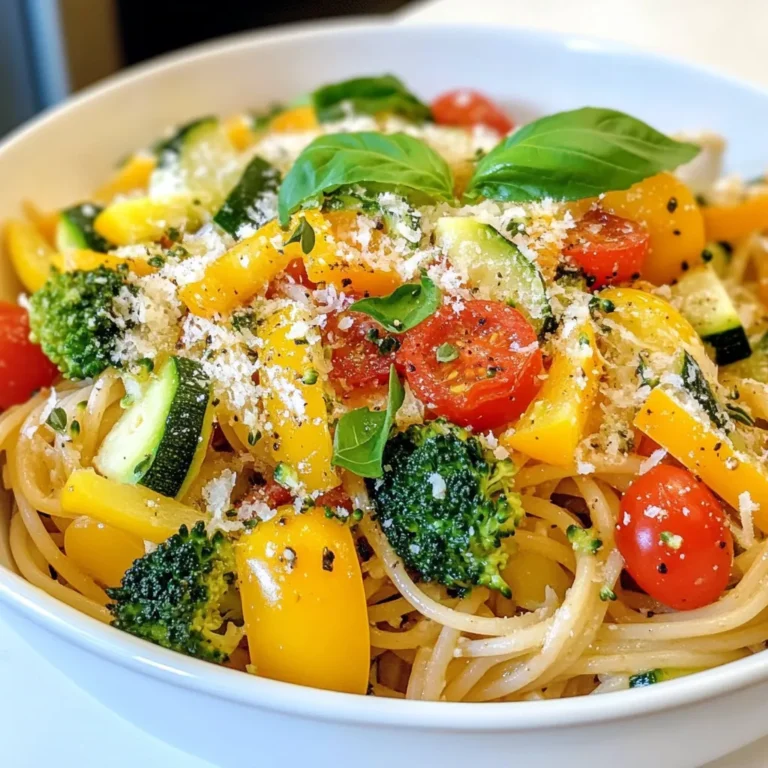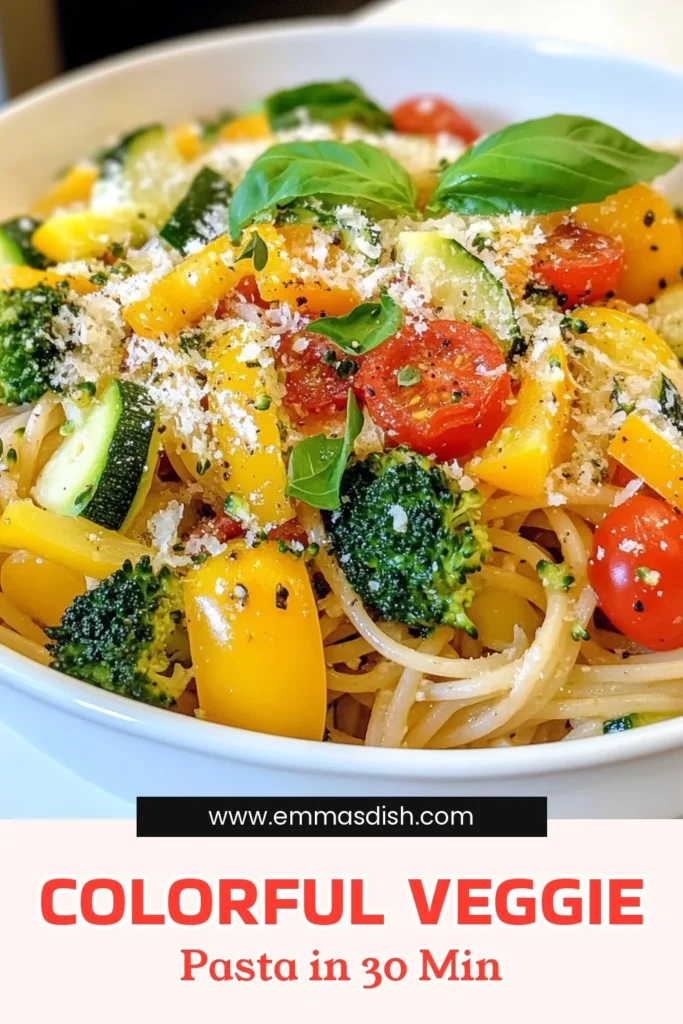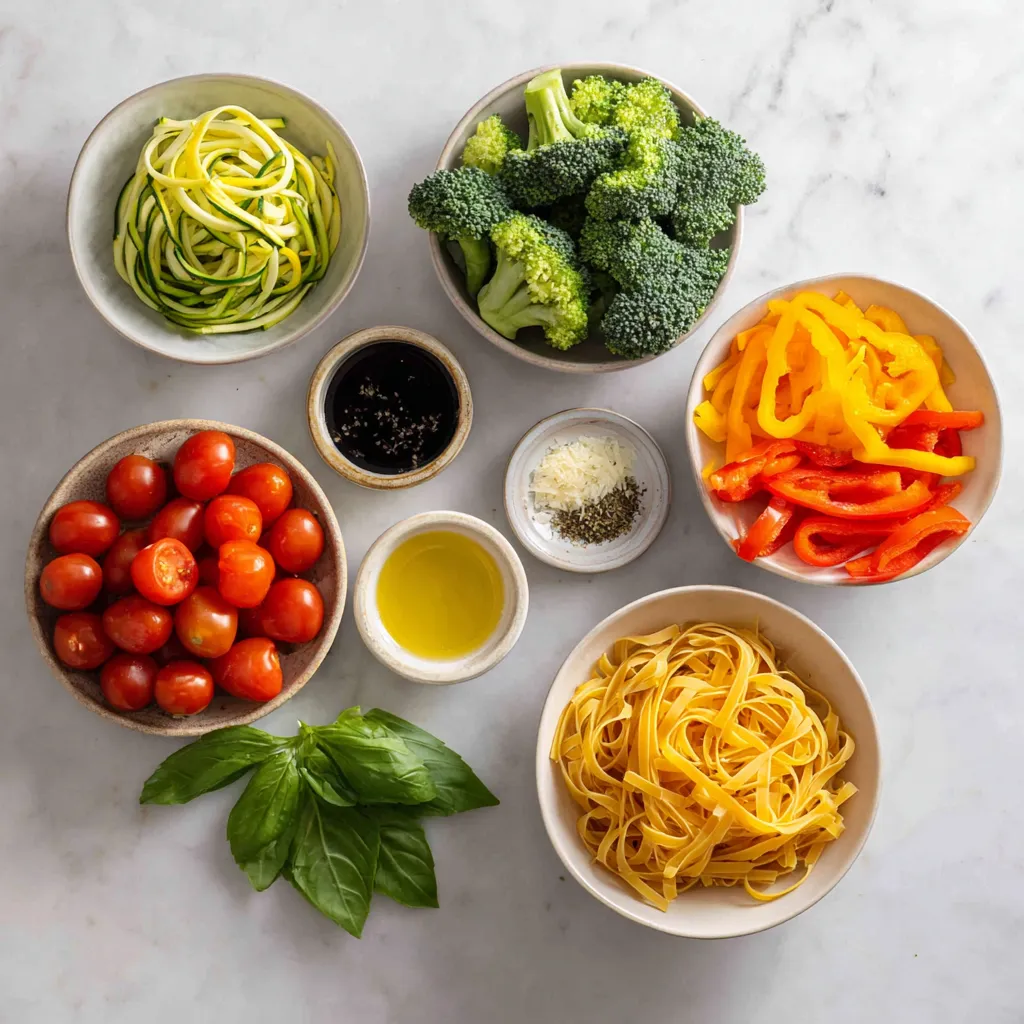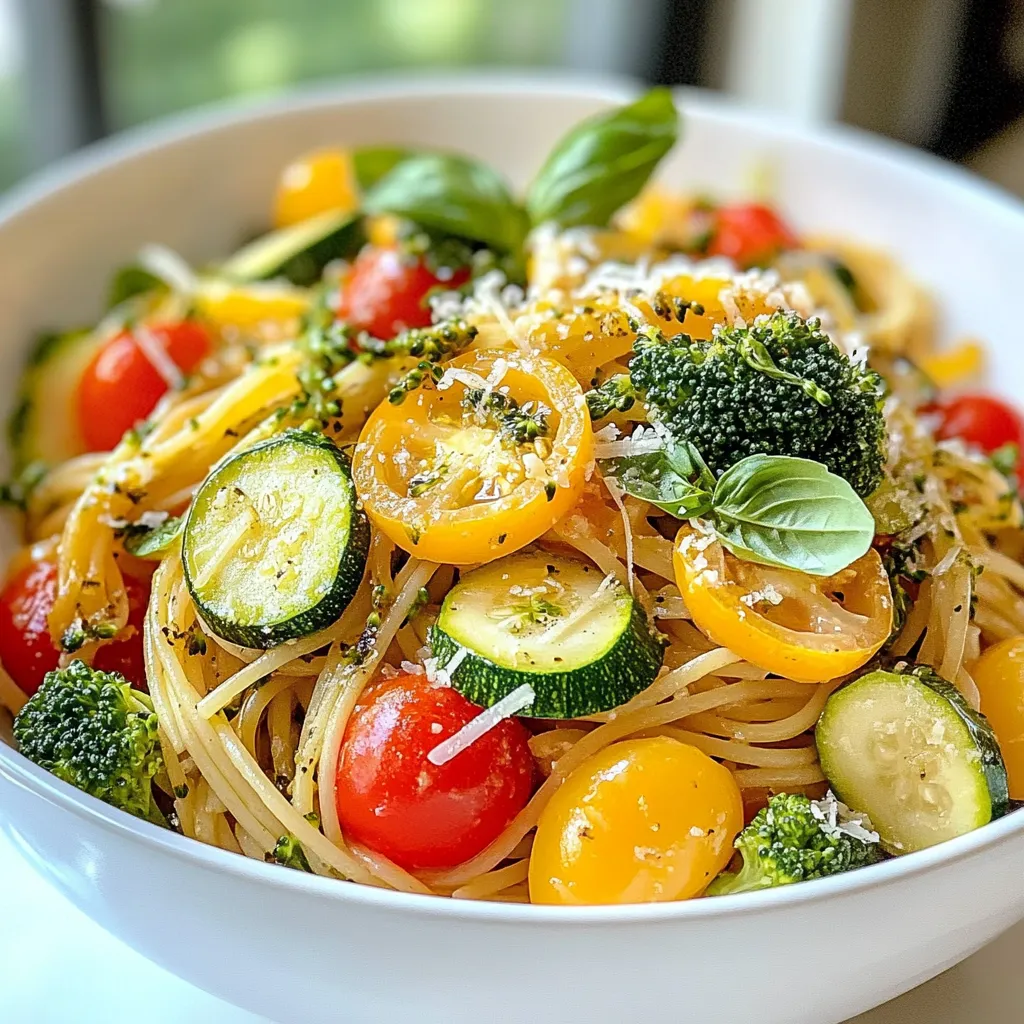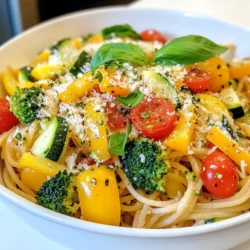WANT TO SAVE THIS RECIPE?
If you crave a dish that’s both fresh and full of flavor, look no further than Vegetarian Pasta Primavera! This vibrant recipe celebrates seasonal veggies, making it an easy choice for anyone seeking a healthy, delicious meal. In this post, I’ll share the must-have ingredients, step-by-step instructions, and helpful tips to elevate your dish. Whether you’re a seasoned chef or a kitchen newbie, you’ll find all you need to create a stunning plate of Pasta Primavera!
Why I Love This Recipe
- Freshness: This dish is a celebration of fresh vegetables, making it a healthy and vibrant choice for any meal.
- Quick and Easy: With a total prep and cook time of just 30 minutes, it’s perfect for busy weeknights.
- Versatile: You can easily swap in your favorite veggies or use what’s in your fridge, making it customizable to your taste.
- Flavorful: The combination of herbs and the optional cheese adds a delicious depth of flavor that elevates the dish.
Ingredients
List of Ingredients
– 8 oz. whole wheat pasta (spaghetti or penne)
– 2 tablespoons olive oil
– 1 small zucchini, julienned
– 1 bell pepper (red or yellow), sliced
– 1 cup cherry tomatoes, halved
– 1 cup broccoli florets
– 1 carrot, thinly sliced
– 3 cloves garlic, minced
– 1 teaspoon dried oregano
– 1 teaspoon dried basil
– Salt and pepper to taste
– ¼ cup grated Parmesan cheese (or nutritional yeast for vegan option)
– Fresh basil leaves for garnish
Substitutions for Key Ingredients
If you can’t find whole wheat pasta, use any pasta you like. For olive oil, you can use avocado oil. Don’t have zucchini? Try yellow squash instead. You can swap bell peppers for any color you prefer. For a nutty flavor, add asparagus or snap peas. Instead of Parmesan cheese, nutritional yeast works great for a vegan option.
Nutritional Information
This dish serves four and offers a healthy meal. Each serving has about:
– Calories: 350
– Protein: 12g
– Carbohydrates: 60g
– Fiber: 8g
– Fat: 10g
– Sodium: 300mg
This pasta is rich in vitamins and minerals from the fresh veggies. Whole wheat pasta adds fiber, making it satisfying and nourishing.

Step-by-Step Instructions
Preparing the Pasta
Start by boiling a large pot of water. Add salt to the water. This helps flavor the pasta. Once it boils, add 8 ounces of whole wheat pasta. You can use spaghetti or penne. Cook it until al dente, which usually takes about 8-10 minutes. Remember to check the package for the exact time. When the pasta is ready, save ½ cup of the pasta water. Then, drain the pasta and set it aside.
Sautéing the Vegetables
Next, grab a large skillet and heat 2 tablespoons of olive oil over medium heat. Once it’s hot, add 3 cloves of minced garlic. Sauté it for about 1 minute until it smells nice. Now, add your veggies: 1 small julienned zucchini, 1 sliced bell pepper, 1 cup of broccoli florets, 1 thinly sliced carrot, and 1 cup of halved cherry tomatoes. Stir these together and cook for about 5-7 minutes. You want them tender but still bright and colorful.
Combining Pasta and Veggies
After your veggies are ready, it’s time to mix everything. Add the drained pasta to the skillet with the vegetables. Pour in a little of the reserved pasta water. Start with a tablespoon at a time until you reach the creaminess you like. Then, sprinkle in 1 teaspoon each of dried oregano and dried basil. Season with salt and pepper to taste. If you want, you can add ¼ cup of grated Parmesan cheese or nutritional yeast for a vegan option. Toss everything together until well combined. Finally, plate your pasta primavera and garnish with fresh basil leaves. Enjoy your vibrant and tasty dish!
Tips & Tricks
How to Achieve the Perfect Al Dente Pasta
To cook pasta just right, start with a big pot of boiling water. Add salt to the water; it should taste like the sea. Toss in your whole wheat pasta and set a timer. Follow the package time closely. Check the pasta one minute before time is up. It should be firm but not hard. This is al dente! Drain it, but save some pasta water for later.
Flavoring Tips for Enhanced Taste
Flavor is key in pasta primavera. Use fresh garlic for a strong taste. Sauté it in olive oil until it smells great. Adding dried oregano and basil brings a nice herbal touch. Don’t forget salt and pepper. Taste as you go! If you want a creamier sauce, add reserved pasta water a little at a time. This helps blend all the flavors together.
Presentation Suggestions
A beautiful plate makes the dish pop! Use vibrant bowls to show off your colorful pasta. Drizzle some extra olive oil on top for shine. Add fresh basil leaves as a garnish. For even more color, sprinkle a little extra cheese on top. It’s all about those little details that make your dish look gourmet!
Pro Tips
- Choose Seasonal Veggies: Using seasonal vegetables not only enhances the flavor but also elevates the nutritional value of your dish.
- Don’t Overcook the Pasta: Ensure your pasta is cooked al dente for the perfect texture that holds up against the sautéed veggies.
- Infuse Flavor with Garlic: Sautéing garlic until just fragrant adds depth to your dish; avoid browning it to keep the flavor mellow.
- Customize with Protein: Add grilled chicken, shrimp, or chickpeas for a protein boost that makes the dish more filling and satisfying.

Variations
Vegan Option: Nutritional Yeast Instead of Cheese
You can easily make this dish vegan. Just swap the Parmesan cheese with nutritional yeast. Nutritional yeast adds a cheesy flavor without any dairy. It is rich in vitamins and great for your health. Use about a quarter cup, just like you would with the cheese. This keeps the dish creamy and flavorful while catering to a vegan diet. You won’t miss the cheese at all!
Add-In Ideas: Protein Options and Additional Veggies
Want to add more protein? Try adding chickpeas or lentils. These options are healthy and easy to mix in. You can also include tofu for a nice texture. For extra veggies, consider spinach, asparagus, or peas. They cook quickly and add color. You can be creative with what you have on hand. Each veggie brings its own flavor, making your dish unique every time.
Gluten-Free Version: Substitute Pasta Options
If you need a gluten-free option, choose gluten-free pasta. Many brands offer rice or quinoa-based pasta that cooks well. You can use the same amount as in the recipe. Just check the cooking time, as it may differ. This way, you can enjoy the same great taste without gluten. Your pasta primavera will still be fresh and delicious!
Storage Info
Storing Leftovers: Best Practices
To keep your Vegetarian Pasta Primavera fresh, store it in an airtight container. This helps avoid dryness and keeps flavors intact. Make sure to cool the dish to room temperature before sealing it. It can last in the fridge for 3 to 5 days. If you want to enjoy it later, consider separating the pasta and veggies. This prevents the pasta from becoming mushy.
Reheating Tips for Optimal Texture
When it’s time to eat leftovers, you want the best texture. Use a skillet for reheating. Add a splash of water or olive oil to keep it moist. Heat it over medium heat for about 5 to 7 minutes. Stir often to ensure even heating. You can also use the microwave. Place it in a microwave-safe bowl, cover it loosely, and heat for 1 to 2 minutes. Stir halfway through to warm it evenly.
Freezing the Dish: What You Need to Know
You can freeze Vegetarian Pasta Primavera for up to 2 months. To do this, let it cool completely. Pack it into freezer-safe bags or containers. Squeeze out as much air as possible before sealing. When ready to eat, thaw it in the fridge overnight. Then, reheat it in a skillet or microwave. The veggies may lose some crunch, but it will still taste great.
FAQs
What is Pasta Primavera?
Pasta Primavera is a fresh pasta dish that highlights seasonal vegetables. The name means “spring pasta” in Italian. You can use any veggies you like. It’s colorful and packed with flavor. This dish pairs well with light sauces or olive oil. I love how simple it is to make.
Can I make Vegetarian Pasta Primavera ahead of time?
Yes, you can prepare Vegetarian Pasta Primavera ahead of time. Cook the pasta and veggies, then cool them. Store them in the fridge for up to two days. When ready to serve, reheat gently in a skillet. Add a splash of olive oil or pasta water to keep it moist.
What are the best vegetables for Pasta Primavera?
The best vegetables for Pasta Primavera include:
– Zucchini
– Bell peppers
– Cherry tomatoes
– Broccoli
– Carrots
Feel free to mix and match based on your taste. Fresh, seasonal veggies give the best flavor. You can also try asparagus, peas, or spinach for variety. Using a mix ensures a bright, colorful dish.
This blog post covered how to create Pasta Primavera. We explored key ingredients, including possible substitutions and nutritional details. I shared step-by-step instructions for preparing pasta and sautéing veggies. Helpful tips ensured your pasta is always perfect. I suggested variations for different diets and storage methods for leftovers.
In conclusion, with these guidelines, you can make delicious Pasta Primavera. Enjoy your cooking, and don’t hesitate to get creativ
Vibrant Veggie Pasta Primavera
A colorful and healthy pasta dish loaded with fresh vegetables and herbs.
Prep Time 10 minutes mins
Cook Time 20 minutes mins
Total Time 30 minutes mins
Course Main Course
Cuisine Italian
Servings 4
Calories 350 kcal
- 8 oz whole wheat pasta (spaghetti or penne)
- 2 tablespoons olive oil
- 1 small zucchini, julienned
- 1 each bell pepper (red or yellow), sliced
- 1 cup cherry tomatoes, halved
- 1 cup broccoli florets
- 1 each carrot, thinly sliced
- 3 cloves garlic, minced
- 1 teaspoon dried oregano
- 1 teaspoon dried basil
- to taste salt and pepper
- 0.25 cup grated Parmesan cheese (or nutritional yeast for vegan option)
- as needed fresh basil leaves for garnish
In a large pot of salted boiling water, cook the whole wheat pasta according to package instructions until al dente. Reserve ½ cup of pasta water, then drain the pasta and set aside.
In a large skillet over medium heat, add the olive oil. Once heated, add the minced garlic and sauté for about 1 minute until fragrant.
Stir in the zucchini, bell pepper, broccoli, carrot, and cherry tomatoes. Sauté for about 5-7 minutes, or until the vegetables are tender but still vibrant in color.
Sprinkle in the dried oregano, dried basil, salt, and pepper. Toss everything together to ensure the vegetables are well coated in the herbs.
Add the drained pasta to the skillet with the sautéed vegetables. Pour in a bit of the reserved pasta water, a tablespoon at a time, until the desired creaminess is achieved.
If using, sprinkle the grated Parmesan cheese over the top and toss until everything is well combined and cheese has melted slightly.
Plate the pasta primavera in bowls, garnishing with fresh basil leaves and an additional sprinkle of Parmesan cheese if desired.
Serve in vibrant pasta bowls, drizzling a little extra olive oil on top and adding a few whole sprigs of fresh basil for a pop of color.
Keyword healthy, pasta, spring, vegetarian
WANT TO SAVE THIS RECIPE?
